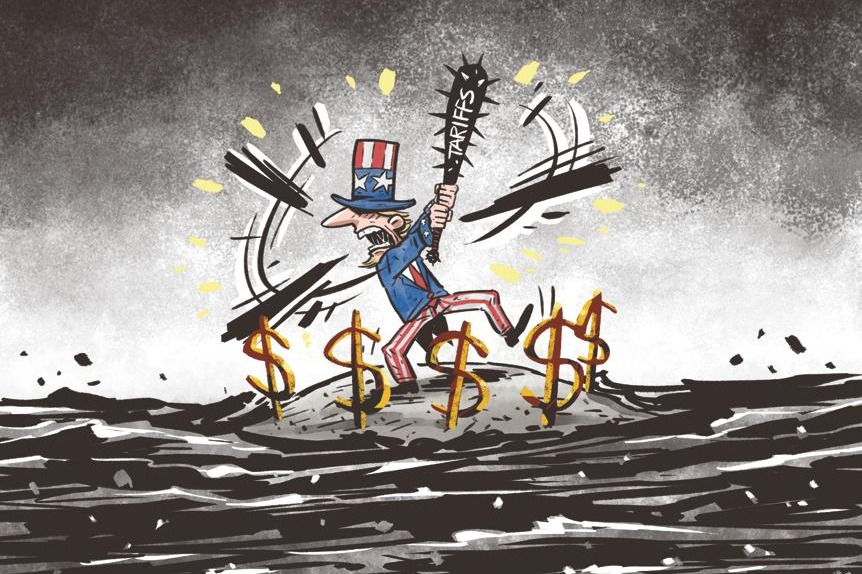Resilience, recovery, new economic frontiers in 2024
Consumer goods trade-in initiative supported by 150b yuan bonds
China Daily | Updated: 2025-01-02 09:02

China's economy demonstrated remarkable resilience and adaptability in 2024 amid complex domestic and global landscapes.
The country's economic trajectory was marked by steady progress and supported by a robust package of measures.
Notable growth was seen in key economic indicators such as industrial output, alongside progress in the stabilization of the real estate market. Targeted reforms, fiscal support and innovation-driven measures bolstered domestic confidence.
And the global significance of China's economic performance is clear.
China's economy is expected to have contributed close to 30 percent of global growth in 2024, highlighting its pivotal role in the international economic landscape.
The country has made significant strides in areas of heightened domestic and international interest — consumption, foreign investment, real estate and green development.
Consumption growth
Despite persistent skepticism about China's consumption prospects, the past year has proven successful, with consumer spending on the rise with fresh highlights.
Though challenges such as subdued consumer sentiment and the ongoing adjustment of the real estate sector have been cited frequently, such narratives do not fully capture the complexity of the situation.
But highlights such as steady development in services and tourism, as well as growth in the large-scale trade-in of goods, paint a more promising picture — one that merits further discussion.
In 2024, the country introduced a series of immediate and long-term initiatives to tap into its immense consumption potential.
These efforts encompassed the enhancement of fiscal investment, an increase in household incomes, dismantling of market barriers, exploration of new avenues for consumption through technological advancements and broader opening of the market.
Some policies have already proved effective, including a consumer goods trade-in initiative, which is supported by 150 billion yuan ($20.55 billion) in funding raised through ultra-long special treasury bonds allocated to local governments.
The effects of this policy are evident in rising spending on home appliances, automobiles and other goods, with sales of white goods and autos up 22.2 percent and 6.6 percent, respectively, in November, said the National Bureau of Statistics.
Broader economic indicators suggest an optimistic outlook. In October, e-commerce logistics hit a five-year high in business volume, while spending on services gained fresh momentum, particularly in the hospitality and dining sectors.
Foreign investment
In a year marked by growing protectionism and attempts toward economic "decoupling" on the global stage, China has nevertheless remained a popular investment destination.
French pharmaceutical giant Sanofi reaffirmed global investor confidence in the Chinese market by announcing in December that it was investing nearly 1 billion euros ($1.04 billion) to build a new insulin production base in Beijing, marking the company's largest single investment in China since 1982.
The investment followed China's announcement of further opening-up in its healthcare sector, including a plan to allow the establishment of wholly foreign-owned hospitals in some major cities, including Beijing and Shanghai, as well as the island province of Hainan, to modernize healthcare services and address rising demand.
An increasing number of companies are joining Sanofi in expanding their presence in China to seize growth opportunities and share in the dividends of the country's continued high-standard opening-up.
In the first 11 months, a record 52,379 foreign-invested companies were established in China, up 8.9 percent from the previous year.
In November, foreign direct investment in the Chinese mainland in actual use climbed 6 percent from the same period a year prior.
Foreign investors are drawn to China for a variety of reasons — its supply chain advantages, innovation-driven growth model and comprehensive offerings that provide everything a company might need.
To help foreign investors capitalize on its supply chain, market and innovation advantages, China has taken significant steps to open up more broadly in 2024. Key measures included expanding industry access and launching pilot programs to attract global investment.
Notably, the 2024 national negative list for foreign investment, effective Nov 1, eliminated all market access restrictions for foreign investors in the manufacturing sector, in a groundbreaking move for global manufacturers entering the Chinese economy.
Property market
Clear signs of recovery have emerged in 2024, bolstered by well-targeted policies that have strengthened confidence and rekindled demand.
In late September, a key meeting convened by the Political Bureau of the Communist Party of China Central Committee underscored the urgency of stabilizing the property market and reversing its downturn.
The meeting called for adjustments to housing purchase restrictions, reductions in mortgage interest rates and improvements to land, fiscal, tax and financial policies.
Responding to these directives, authorities have lowered home-purchase costs, eased mortgage burdens, and extended critical support for first-time buyers and those seeking to upgrade their living arrangements.
On Sept 29, the central bank instructed commercial banks to cut interest rates on existing mortgages, including first and second-home loans, to no less than 30 basis points below the loan prime rate by Oct 31, aiming to alleviate financial pressure on homeowners.
Subsequently, major cities such as Beijing, Shanghai, and Guangdong province's Guangzhou and Shenzhen have introduced tailored measures to boost their local property markets via another round of policy adjustments.
These efforts have built on measures announced in May, which included cutting minimum down-payment ratios, establishing a re-lending facility for affordable housing and pledging to complete unfinished residential projects.
The impact of these policy measures is becoming increasingly evident. In November, the year-on-year decline in commercial residential property prices across 70 large and medium-sized cities narrowed, pointing to early signs of recovery and stabilization in the housing market.
Xinhua
























